Merchant

 Clash Royale CLAN TAG#URR8PPP
Clash Royale CLAN TAG#URR8PPP

Merchants from Holland and the Middle East trading.
A merchant is a person who trades in commodities produced by other people. Historically, a merchant is anyone who is involved in business or trade. Merchants have been known for as long as industry, commerce, and trade have existed. During the 16th-century, in Europe, two different terms for merchants emerged: One term, meerseniers, described local traders such as bakers, grocers, etc.; while a new term, koopman, described merchants who operated on a global stage, importing and exporting goods over vast distances, and offering added value services such as credit and finance.
The status of the merchant has varied during different periods of history and among different societies. In ancient Rome and Greece, merchants may have been wealthy, but were not accorded high social status. In contrast, in the Middle East, where markets were an integral part of the city, merchants enjoyed high status. In modern times, the term occasionally has been used to refer to a businessperson or someone undertaking activities (commercial or industrial) for the purpose of generating profit, cash flow, sales, and revenue utilizing a combination of human, financial, intellectual and physical capital with a view to fuelling economic development and growth.

A scale or balance is often used to symbolise a merchant
Merchants have been known for as long as humans have engaged in trade and commerce. Merchants and merchant networks were known to operate in ancient Babylonia and Assyria, China, Egypt, Greece, India, Persia, Phoenicia and Rome. During the European medieval period, a rapid expansion in trade and commerce, led to the rise of a wealthy and powerful merchant class. The European age of discovery opened up new trading routes and gave European consumers access to a much broader range of goods. From the 1600s, goods began to travel much further distances as they found their way into geographically dispersed market places. Following the opening Asia and the discovery of the New World, goods were imported from very long distances: calico cloth from India, porcelain, silk and tea from China, spices from India and South-East Asia and tobacco, sugar, rum and coffee from the New World. By the eighteenth century, a new type of manufacturer-merchant was emerging and modern business practices were becoming evident.
Contents
1 Etymology and usage
2 Types of merchant
3 History
3.1 Merchants in antiquity
3.2 Merchants in the medieval period
3.3 Merchants in the modern era
4 In art
5 In architecture
6 See also
7 References and sources
8 External links
Etymology and usage

Costumes of merchants from Brabant and Antwerp, engraving by Abraham de Bruyn, 1577
The English term, "merchant" comes from the Middle English, marchant, which itself originated from the Vulgar Latin mercatant or mercatans, formed from present participle of mercatare meaning to trade, to traffic or to deal in.[1] The term is used to refer to any type of reseller, but can also be used with a specific qualifier to suggest a person who deals in a given characteristic such as "speed merchant" to refer to someone who enjoys fast driving; a "noise merchant", used to refer to a group of musical performers.[2] Other known uses of the term include: "dream merchant" used to describe someone who peddles idealistic visionary scenarios and "merchant of war" to describe proponents of war.
Elizabeth Honig has argued that concepts relating to the role of a merchant began to change in the mid-16th century. The Dutch term, koopman (meaning merchant), became rather more fluid during the 16th century when Antwerp was the most global market town in Europe. Two different terms, for a merchant, began to be used, meerseniers referred to local merchants including bakers, grocers, sellers of dairy products and stall-holders, while the alternate term, koopman, was used to describe those who traded in goods or credit on a large scale. This distinction was necessary to separate the daily trade that the general population understood from the rising ranks of traders who took up their places on a world stage and were seen as quite distant from everyday experience.[3]
Types of merchant
Broadly, merchants can be classified into two categories:
- A wholesale merchant operates in the chain between the producer and retail merchant, typically dealing in large quantities of goods.[4] In other words, a wholesaler does not sell directly to end-users. Some wholesale merchants only organize the movement of goods rather than move the goods themselves.
- A retail merchant or retailer sells merchandise to end-users or consumers (including businesses), usually in small quantities. A shop-keeper is a retail merchant.
However, the term 'merchant' is often used in a variety of specialised contexts such as in merchant banker, merchant navy or merchant services.
History
Merchants in antiquity

Phoenician trade route map
Merchants have existed as long as business, trade and commerce have been conducted.[5] A merchant class characterized many pre-modern societies. Open air, public markets, where merchants and traders congregated, were known in ancient Babylonia and Assyria, China, Egypt, Greece, India, Persia, Phoenicia and Rome. These markets typically occupied a place in the town's centre. Surrounding the market, skilled artisans, such as metal-workers and leather workers, occupied premises in alley ways that led to the open market-place. These artisans may have sold wares directly from their premises, but also prepared goods for sale on market days.[6] In ancient Greece markets operated within the agora (open space), and in ancient Rome the forum. Rome had two forums; the Forum Romanum and Trajan's Forum. The latter was a vast expanse, comprising multiple buildings with shops on four levels. The Roman forum was arguably the earliest example of a permanent retail shop-front.[7]
In antiquity, exchange involved direct selling through permanent or semi-permanent retail premises such as stall-holders at market places or shop-keepers selling from their own premises or through door-to-door direct sales via merchants or peddlers. The nature of direct selling centred around transactional exchange, where the goods were on open display, allowing buyers to evaluate quality directly through visual inspection. Relationships between merchant and consumer were minimal[8] often playing into public concerns about the quality of produce.[9]

Phoenician merchants traded across the entire Mediterranean region
The Phoenicians were well known amongst contemporaries as "traders in purple" – a reference to their monopoly over the purple dye extracted from the murex shell.[10] The Phoenicians plied their ships across the Mediterranean, becoming a major trading power by the 9th century BCE. Phoenician merchant traders imported and exported wood, textiles, glass and produce such as wine, oil, dried fruit and nuts. Their trading skills necessitated a network of colonies along the Mediterranean coast, stretching from modern day Crete through to Tangiers and onto Sardinia.[11] The Phoenicians not only traded in tangible goods, but were also instrumental in transporting the trappings of culture. The Phoenician's extensive trade networks necessitated considerable book-keeping and correspondence. In around 1500 BCE, the Phoenicians developed a phonetic alphabet which was much easier to learn that the pictographic scripts used in ancient Egypt and Mesopotamia. Phoenician traders and merchants were largely responsible for spreading their alphabet around the region.[12] Phoenician inscriptions have been found in archaeological sites at a number of former Phoenician cities and colonies around the Mediterranean, such as Byblos (in present-day Lebanon) and Carthage in North Africa.[13]

Wall painting from Pompeii depicting every day activities at a market-place

Mosaic showing garum container, from the house of Umbricius Scaurus of Pompeii. The inscription which reads "G(ari) F(los) SCO(mbri) SCAURI EX OFFI(CI)NA SCAURI" has been translated as "The flower of garum, made of the mackerel, a product of Scaurus, from the shop of Scaurus"
The social status of the merchant class varied across cultures; ranging from high status (the members even eventually achieving titles such as that of Merchant Prince or Nabob) to low status, as in China, Greece and Roman cultures, owing to the presumed distastefulness of profiting from "mere" trade rather than from labor or the labor of others as in agriculture and craftsmanship.[14] The Romans defined merchants or traders in a very narrow sense. Merchants were those who bought and sold goods while landowners who sold their own produce were not considered to be merchants. Being a landowner was a 'respectable' occupation. On the other hand, the trade of merchant was not considered 'respectable'.[15] In the ancient cities of the Middle East, where the bazaar was the city's focal point and heartbeat, merchants who worked in bazaar were considered to be among the high-ranking members of the society.[16] Medieval attitudes toward merchants in the West were strongly influenced by criticism of their activities by the Christian church, which closely associated their activities with the sin of usury.[17]
In Greco-Roman society, merchants typically did not have high social status, though they may have enjoyed great wealth.[18] Umbricius Scauras, for example, was a manufacturer and trader of fish sauce (also known as garum) in Pompeii, circa 35 C.E. His villa, situated in one of the wealthier districts of Pompeii, was very large and ornately decorated in a show of substantial personal wealth. Mosaic patterns in the floor of his atrium were decorated with images of amphora bearing his personal brand and bearing quality claims. One of the inscriptions on the mosaic amphora reads "G(ari) F(los) SCO[m]/ SCAURI/ EX OFFI[ci]/NA SCAU/RI" which translates as "The flower of garum, made of the mackerel, a product of Scaurus, from the shop of Scaurus." The reputation of Scauras' fish sauce was known to be of very high quality across the Mediterranean and its reputation travelled as far away as modern southern France.[19] Other notable Roman merchants include: Marcus Julius Alexander, Sergius Orata and Annius Plocamus.
In the Roman world, local merchants served the needs of the wealthier landowners. While the local peasantry, who were generally poor, relied on open air market places to buy and sell produce and wares, major producers such as the great estates were sufficiently attractive for merchants to call directly at their farm-gates. The very wealthy landowners managed their own distribution, which may have involved exporting.[20] Markets were also important centres of social life and merchants helped to spread news and gossip.[21]
The nature of export markets in antiquity is well documented in ancient sources and archaeological case studies. Both Greek and Roman merchants engaged in long-distance trade. A Chinese text records that a Roman merchant named Lun reached southern China in 226 CE. Roman objects, dating from the period 27 BCE to 37 CE, have been excavated in sites as far afield as the Kushan and Indus ports. The Romans sold purple and yellow dyes, brass and iron and acquired incense, balsalm, expensive liquid myrrh and spices from the Near East and India, fine silk from China[22] and fine white marble destined for the Roman wholesale market from Arabia. For Roman consumers, the purchase of goods from the East was a symbol of social prestige.[23]
Merchants in the medieval period
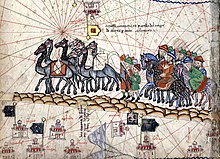
Marco Polo was among the earliest European merchants to travel to the Orient, helping to open it up to trade in the 13th century
Medieval England and Europe witnessed a rapid expansion in trade and the rise of a wealthy and powerful merchant class. Blintiff has investigated the early Medieval networks of market towns and suggests that by the 12th century there was an upsurge in the number of market towns and the emergence of merchant circuits as traders bulked up surpluses from smaller regional, different day markets and resold them at the larger centralised market towns. Peddlers or itinerant merchants filled any gaps in the distribution system.[24] From the 11th century, the Crusades helped to open up new trade routes in the Near East, while the adventurer and merchant, Marco Polo stimulated interest in the far East in the 12th and 13th centuries. Medieval merchants began to trade in exotic goods imported from distant shores including spices, wine, food, furs, fine cloth (notably silk), glass, jewellery and many other luxury goods. Market towns began to spread across the landscape during the medieval period.
Merchant guilds began to form during the Medieval period. A fraternity formed by the merchants of Tiel in Gelderland (in present-day Netherlands) in 1020 is believed to be the first example of a guild. The term, "guild" was first used for gilda mercatoria to describe a body of merchants operating out of St. Omer, France in the 11th century and London's Hanse was formed in the 12th century.[25] These guilds controlled the way that trade was to be conducted and codified rules governing the conditions of trade. Rules established by merchant guilds were often incorporated into the charters granted to market towns. In the early 12th century, a confederation of merchant guilds, formed out the German cities of Lubeck and Hamburg, known as "The Hanseatic League" came to dominate trade around the Baltic Sea. By the 13th and 14th centuries, merchant guilds had sufficient resources to have erected guild halls in many major market towns.[26]

Mediterranean port with Turkish merchants by Adriaen van der Kabel, 1682
During the thirteenth century, European businesses became more permanent and were able to maintain sedentary merchants and a system of agents. Merchants specialised in financing, organisation and transport while agents were domiciled overseas and acted on behalf of a principal. These arrangements first appeared on the route from Italy to the Levant, but by the end of the thirteenth century merchant colonies could be found from Paris, London, Bruges, Seville, Barcelona and Montpellier. Over time these partnerships became more commonplace and led to the development of large trading companies. These developments also triggered innovations such as double-entry book-keeping, commercial accountancy, international banking including access to lines of credit, marine insurance and commercial courier services. These developments are sometimes known as the commercial revolution.[27]
Luca Clerici has made a detailed study of Vicenza’s food market during the sixteenth century. He found that there were many different types of merchants operating out of the markets. For example, in the dairy trade, cheese and butter was sold by the members of two craft guilds (i.e., cheesemongers who were shopkeepers) and that of the so-called ‘resellers’ (hucksters selling a wide range of foodstuffs), and by other sellers who were not enrolled in any guild. Cheesemongers’ shops were situated at the town hall and were very lucrative. Resellers and direct sellers increased the number of sellers, thus increasing competition, to the benefit of consumers. Direct sellers, who brought produce from the surrounding countryside, sold their wares through the central market place and priced their goods at considerably lower rates than cheesemongers.[28]

A merchant making up the account by Katsushika Hokusai.
From 1300 through to the 1800s a large number of European chartered and merchant companies were established to exploit international trading opportunities. The Company of Merchant Adventurers of London, chartered in 1407, controlled most of the fine cloth imports[29] while the Hanseatic League controlled most of the trade in the Baltic Sea. A detailed study of European trade between the thirteenth and fifteenth century demonstrates that the European age of discovery acted as a major driver of change. In 1600, goods travelled relatively short distances: grain 5–10 miles; cattle 40–70 miles; wool and wollen cloth 20–40 miles. However, in the years following the opening up of Asia and the discovery of the New World, goods were imported from very long distances: calico cloth from India, porcelain, silk and tea from China, spices from India and South-East Asia and tobacco, sugar, rum and coffee from the New World.[30]
In Mesoamerica, a tiered system of traders developed independently. The local markets, where people purchased their daily needs were known as tianguis while pochteca was the term used to describe long-distance, professional merchants traders who obtained rare goods and luxury items desired by the nobility. This trading system supported various levels of pochteca – from very high status merchants through to minor traders who acted as a type of peddler to fill in gaps in the distribution system.[31] The Spanish conquerors commented on the impressive nature of the local and regional markets in the 15th century. The Mexica (Aztec) market of Tlatelolco was the largest in all the Americas and said to be superior to those in Europe.[32]
Merchants in the modern era
The modern era is generally understood to refer to period that coincides with the rise of consumer culture in seventeenth and eighteenth century Europe.[33] As standards of living improved in the 17th century, consumers from a broad range of social backgrounds began to purchase goods that were in excess of basic necessities. An emergent middle class or bourgeosie stimulated demand for luxury goods and the act of shopping came to be seen as a pleasurable pass-time or form of entertainment.[34]

Merchants engaged in international trade began to develop a more outward-looking mindset
As Britain embarked on colonial expansion, large commercial organisations were much in need of sophisticated information about trading conditions in foreign lands. Daniel Defoe, a London merchant, published information on trade and economic resources of England, Scotland and India.[35][36] Defoe was a prolific pamphleteer and among his many publications are titles devoted to trade including; Trade of Britain Stated, 1707; Trade of Scotland with France, 1713; The Trade to India Critically and Calmly Considered, 1720 and A Plan of the English Commerce 1731; all pamphlets that were highly popular with contemporary merchants and business houses.[37]
Eighteenth century merchants, who traded in foreign markets, developed a network of relationships which crossed national boundaries, religious affiliations, family ties, and gender. The historian, Vannneste, has argued that a new cosmopolitan merchant mentality based on trust, reciprosity and a culture of communal support developed and helped to unify the early modern world. Given that these cosmopolitan merchants were embedded within their societies and participated in the highest level of exchange, they transferred a more outward-looking mindset and system of values to their commercial exchange transactions, and also helped to disseminate a more global awareness to broader society and therefore acted as agents of change for local society. Successful, open-minded cosmopolitan merchants began to acquire a more esteemed social position with the political elites. They were often sought as advisors for high-level political agents[38]
By the eighteenth century, a new type of manufacturer-merchant was emerging and modern business practices were becoming evident. Many merchants held showcases of goods in their private homes for the benefit of wealthier clients.[39] Samuel Pepys, for example, writing in 1660, describes being invited to the home of a retailer to view a wooden jack.[40] McKendrick, Brewer and Plumb found extensive evidence of eighteenth century English entrepreneurs and merchants using 'modern' marketing techniques, including product differentiation, sales promotion and loss leader pricing.[41] English industrialists, Josiah Wedgewood and Matthew Boulton, are often portrayed as pioneers of modern mass marketing methods.[42] Wedgewood was known to have used marketing techniques such as direct mail, travelling salesmen and catalogues in the eighteenth century.[43] Wedgewood also carried out serious investigations into the fixed and variable costs of production and recognised that increased production would lead to lower unit costs. He also inferred that selling at lower prices would lead to higher demand and recognised the value of achieving scale economies in production. By cutting costs and lowering prices, Wedgewood was able to generate higher overall profits.[44] Similarly, one of Wedgewood's contemporaries, Matthew Boulton, pioneered early mass production techniques and product differentiation at his Soho Manufactory in the 1760s. He also practiced planned obsolescence and understood the importance of "celebrity marketing" – that is supplying the nobility, often at prices below cost and of obtaining royal patronage, for the sake of the publicity and kudos generated.[45] Both Wedgewood and Boulton staged expansive showcases of their wares in their private residences or in rented halls.[46]
Eighteenth-century American merchants, who had been operating as importers and exporters, began to specialise in either wholesale or retail roles. They tended not to specialise in particular types of merchandise, often trading as general merchants, selling a diverse range of product types. These merchants were concentrated in the larger cities. They often provided high levels of credit financing for retail transactions.[47]
In art
Elizabeth Honig has argued that artists, especially the Dutch painters of Antwerp, developed a fascination with merchants from the mid-16th century. At this time, the economy was undergoing profound changes – capitalism emerged as the dominant social organisation replacing earlier modes of production. Merchants were importing produce from afar – grain from the Baltic, textiles from England, wine from Germany and metals from various countries. Antwerp was the centre of this new commercial world. The public began to distinguish between two types of merchant, the meerseniers which referred to local merchants including bakers, grocers, sellers of dairy products and stall-holders, and the koopman, which described a new, emergent class of trader who dealt in goods or credit on a large scale. With the rise of a European merchant class, this distinction was necessary to separate the daily trade that the general population understood from the rising ranks of traders who operated on a world stage and were seen as quite distant from everyday experience.[48] The wealthier merchants also had the means to commission artworks with the result that individual merchants and their families became important subject matter for artists. For instance, Hans Holbein, the younger painted a series of portraits of Hanseatic merchants working out of London's Steelyard in the 1530s. [49] These included including Georg Giese of Danzig; Hillebrant Wedigh of Cologne; Dirk Tybis of Duisburg; Hans of Antwerp, Hermann Wedigh, Johann Schwarzwald, Cyriacus Kale, Derich Born and Derick Berck. [50] Paintings of groups of merchants, notably officers of the merchant guilds, also became subject matter for artists and documented the rise of important mercantile organisations.
In recent art: Dutch photographer Loes Heerink spend hours on bridges in Hanoi to take pictures of Vietnamese street Merchants. She published a book called Merchants in Motion: the art of Vietnamese Street Vendors.

A Jewish merchant and his family by Paolo Uccello 1465-1469

The Arnolfini Portrait, believed to be of Italian merchant, Giovanni de Nicolao Arnolfini with his wife, by Jan Van Eyck, c. 1434
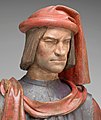
Lorenzo de' Medici, merchant, Florentine bust, 14th or 15th century

Mathias Mulich (1470-1528), Merchant in Lübeck, by Jacob Claesz van Utrecht, c. 1522

Portrait of Anton Fugger by Hans Maler zu Schwaz, c. 1525
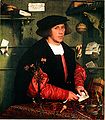
Portrait of George Gisze, the merchant, by Hans Holbein the Younger, c 1532

Portrait of a member of the Wedigh merchant family by Hans Holbein the Younger, c. 1532

The Hanseatic merchant, Cyriacus Kale, by Hans Holbein the Younger, c. 1533

A Hanseatic merchant, by Hans Holbein the Younger, c 1538

Portrait of a Merchant by Corneille de Lyon, c. 1541

Sir Thomas Gresham by Anthonis Mor, c. 1560.

Cornelis van der Geest, merchant of Antwerp, by Anthony van Dyck, c. 1620

Portrait of Nicolaes van der Borght, merchant of Antwerp by Van Dyk, 1625–35

Portrait of the cloth merchant, Abraham del Court and his wife Maria de Keerssegieter by Bartelmeus van der Helst, c. 1654

Frederick Rihel, a merchant on horseback by Rembrandt, c. 1663

Portrait of Amsterdam merchant, Cornelis Nuyts (1574-1661) by Jürgen Ovens

Portrait of Joshua van Belle, merchant in Spain by Bartolomé Esteban Murillo, c. 1670

Portrait of Pieter Cnoll, senior merchant of Batavia, with family, by Jacob Janz Coeman, c.1655
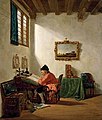
The Merchant by Abraham van Strij c. 1800

Caspar Voght, German merchant, 1801 by Jean-Laurent Mosnier

Joshua Watson, English wine merchant, 1863

The Carpet Merchant by Jean-Léon Gérôme, c 1887
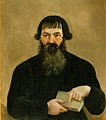
Merchant Sytov by anonymous (Rybinsk museum), mid-19th century

Governors of the Wine Merchant's Guild by Ferdinand Bol, c. 1680

The Syndics of the Drapers' Guild by Rembrandt, c. 1662

Four officers of the Amsterdam Coopers and wine-rackers Guild by Gerbrand Jansz van den Eeckhout, c. 1660

Reception of Jan Karel de Cordes at the guild hall by Balthasar van den Bossche, c.1711
In architecture
Although merchant halls were known in antiquity, they fell into disuse and were not reinvented until Europe's Medieval period.[51] During the 12th century, powerful guilds which controlled the way that trade was conducted were established and were often incorporated into the charters granted to market towns. By the 13th and 14th centuries, merchant guilds had acquired sufficient resources to erect guild halls in many major market towns.[52] Many buildings have retained the names derived from their former use as the home or place of business of merchants:

The Merchant's House, Kirkcaldy, Scotland

Merchant Tower, Kentucky, USA
Medieval merchant's house, Southampton, England

Tudor Merchant's Hall, Southampton, England

Drapers' Hall, Coventry, England

The Blacksmiths' Guild Hall, Venice, Italy

Shoemakers' Guild Hall, Venice, Italy
Brodhaus, Bakers' Guild, Einbeck, Germany

Knochenhaueramtshaus, Butcher`s guild hall, Hildesheim, Germany

The Butcher's Hall, Antwerp, Belgium

The Hanseatic League Building, Antwerp, 16th century
See also
- Businessperson
- Capitalism
- Chapmen
- Commerce
- Costermonger
- Distribution
- Entrepreneur
- Free market
- Free trade
- Guild
- Guildhall
- Hawker
- History of marketing
- Licensed victualler
- Market (place)
- Mercantilism
- Merchant account
- Merchant marine
- Peddler
- Phoenicians and wine
- Pochteca
- Retail
- Roman commerce
References and sources
- References
^ Merriam-Webster Dictionary, https://www.merriam-webster.com/dictionary/merchant
^ Online Dictionary of Etymology, http://www.etymonline.com/index.php?term=merchant
^ Honig, E.A., Painting & the Market in Early Modern Antwerp, Yale University Press, 1998, pp 4-10
^ Longman Dictionary of Contemporary English, 2013. mer‧chant
^ Demirdjian, Z. S., "Rise and Fall of Marketing in Mesopotamia: A Conundrum in the Cradle of Civilization," In The Future of Marketing's Past: Proceedings of the 12th Annual Conference on Historical Analysis and Research in Marketing, Leighton Neilson (ed.), CA, Longman, Association for Analysis and Research in Marketing, 2005
^ Bintliff, J., "Going to Market in Antiquity," In Stuttgarter Kolloquium zur Historischen Geographie des Altertums, Eckart Olshausen and Holger Sonnabend (eds), Stuttgart, Franz Steiner, 2002, pp 209–250
^ Coleman, P., Shopping Environments, Elsevier, Oxford, 2006, p. 28
^
Shaw, Eric H. (2016). "2: Ancient and medieval marketing". In Jones, D.G. Brian; Tadajewski, Mark. The Routledge Companion to Marketing History. Routledge Companions. London: Routledge. p. 24. ISBN 9781134688685. Retrieved 2017-01-03.Perhaps the only substantiated type of retail marketing practice that evolved from Neolithic times to the present was the itinerant tradesman (also known as peddler, packman or chapman). These forerunners of travelling salesmen roamed from village to village bartering stone axes in exchange for salt or other goods (Dixon, 1975).
.mw-parser-output cite.citationfont-style:inherit.mw-parser-output qquotes:"""""""'""'".mw-parser-output code.cs1-codecolor:inherit;background:inherit;border:inherit;padding:inherit.mw-parser-output .cs1-lock-free abackground:url("//upload.wikimedia.org/wikipedia/commons/thumb/6/65/Lock-green.svg/9px-Lock-green.svg.png")no-repeat;background-position:right .1em center.mw-parser-output .cs1-lock-limited a,.mw-parser-output .cs1-lock-registration abackground:url("//upload.wikimedia.org/wikipedia/commons/thumb/d/d6/Lock-gray-alt-2.svg/9px-Lock-gray-alt-2.svg.png")no-repeat;background-position:right .1em center.mw-parser-output .cs1-lock-subscription abackground:url("//upload.wikimedia.org/wikipedia/commons/thumb/a/aa/Lock-red-alt-2.svg/9px-Lock-red-alt-2.svg.png")no-repeat;background-position:right .1em center.mw-parser-output .cs1-subscription,.mw-parser-output .cs1-registrationcolor:#555.mw-parser-output .cs1-subscription span,.mw-parser-output .cs1-registration spanborder-bottom:1px dotted;cursor:help.mw-parser-output .cs1-hidden-errordisplay:none;font-size:100%.mw-parser-output .cs1-visible-errorfont-size:100%.mw-parser-output .cs1-subscription,.mw-parser-output .cs1-registration,.mw-parser-output .cs1-formatfont-size:95%.mw-parser-output .cs1-kern-left,.mw-parser-output .cs1-kern-wl-leftpadding-left:0.2em.mw-parser-output .cs1-kern-right,.mw-parser-output .cs1-kern-wl-rightpadding-right:0.2em
^ Stabel, P., "Guilds in Late Medieval Flanders: myths and realities of guild life in an export-oriented environment," Journal of Medieval History, vol. 30, 2004, pp 187–212
^ Rawlinson, G., History of Phoenicia, Library of Alexandria, 1889
^ Cartwright, M., "Trade in the Phoenician World", Ancient History Encyclopedia, 1 April 2016
^ Daniels (1996) p. 94–95.
^ John Noble Wilford (November 13, 1999) "Discovery of Egyptian Inscriptions Indicates an Earlier Date for Origin of the Alphabet", New York Times, <Online: https://www.nytimes.com/library/national/science/111499sci-alphabet-origin.html>
^ Oka, R. and Kusimba, C.M., "The Archaeology of Trading Systems, Part 1: Towards a New Trade Synthesis," The Archaeology of Trading Systems, Part 1: Towards a New Trade Synthesis," Journal of Archaeological Research, Vol. 16, p. 359
^ Tchernia, A., The Romans and Trade, Oxford, Oxford University Press, 2016, Ch 1
^ Ashraf, A., "Bazaar-Mosque Alliance: The Social Basis of Revolts and Revolutions," International Journal of Politics, Culture, and Society, Vol. 1, No. 4, 1988, pp. 538-567, Stable URL: https://www.jstor.org/stable/20006873, p. 539
^ "Decameron Web – Society". Brown.edu. Archived from the original on 28 April 2013. Retrieved 8 February 2017.
^ Barnish, S.J.B. (1989) "The Transformation of Classical Cities and the Pirenne Debate", Journal of Roman Archaeology, Vol. 2, p. 390.
^ Curtis, R.I., "A Personalized Floor Mosaic from Pompeii," American Journal of Archaeology, Vol. 88, No. 4 (October 1984), DOI: 10.2307/504744, pp. 557-566, Stable URL: https://www.jstor.org/stable/504744
^ Bintliff, J., "Going to Market in Antiquity," In Stuttgarter Kolloquium zur Historischen Geographie des Altertums, Eckart Olshausen and Holger Sonnabend (eds), Stuttgart, Franz Steiner, 2002, p. 229
^ Millar, F., "The World of the Golden Ass", Journal of Roman Studies, Vol. 71, 1981, pp. 63–67
^ McLaughlin, R., The Roman Empire and the Silk Routes: The Ancient World Economy and the Empires of Parthia, Central Asia and Han China,South Yorkshire, Pen and Sword Books, 2016
^ McLaughlin, R., The Roman Empire and the Indian Ocean: The Ancient World Economy and the Kingdoms of Africa, Arabia and India, South Yorkshire, Pen and Sword Books, 2014 p. 135
^ Bintliff, J., "Going to Market in Antiquity", In Stuttgarter Kolloquium zur Historischen Geographie des Altertums, Eckart Olshausen and Holger Sonnabend (eds), Stuttgart, Franz Steiner, 2002, p. 224
^ Encyclopædia Britannica Online: https://www.britannica.com/topic/merchant-guild
^ Epstein, S.A, Wage Labor and Guilds in Medieval Europe, University of North Carolina Press, 1991, pp 50-100
^ Casson, M. and Lee, J., "The Origin and Development of Markets: A Business History Perspective," Business History Review, Vol 85, Spring, 2011, doi:10.1017/S0007680511000018, pp 22–26
^ Clerici, L., "Le prix du bien commun. Taxation des prix et approvisionnement urbain (Vicence, XVIe-XVIIe siècle)" [The price of the common good. Official prices and urban provisioning in sixteenth and seventeenth century Vicenza] in I prezzi delle cose nell’età preindustriale /The Prices of Things in Pre-Industrial Times, [forthcoming], Firenze University Press, 2017.
^ "Merchant Adventurers" in Encyclopædia Britannica, Online Library Edition, 2013. Retrieved 22 July 2013.
^ Braudel, F. and Reynold, S., The Wheels of Commerce: Civilization and Capitalism, 15th to 18th Century, Berkeley CA, University of California Press, 1992
^ Salomón, F., "Pochteca and mindalá: a comparison of long-distance traders in Ecuador and Mesoamerica," Journal of the Steward Anthropological Society, Vol. 1-2, 1978, pp 231-246
^ Rebecca M. Seaman (ed.). Conflict in the Early Americas: An Encyclopedia of the Spanish Empire's Aztec, Incan and Mayan Conquests. p. 375.
^ Southerton, D. (ed.), Encyclopedia of Consumer Culture, Thousand Oaks, CA, Sage, 2011 p. xxx
^ Jones, C. and Spang, R., "Sans Culottes, Sans Café, Sans Tabac: Shifting Realms of Luxury and Necessity in Eighteenth-Century France," Chapter 2 in Consumers and Luxury: Consumer Culture in Europe, 1650-1850 Berg, M. and Clifford, H., Manchester University Pres, 1999; Berg, M., "New Commodities, Luxuries and Their Consumers in Nineteenth-Century England," Chapter 3 in Consumers and Luxury: Consumer Culture in Europe, 1650-1850 Berg, M. and Clifford, H., Manchester University Press, 1999
^ Minto, W., Daniel Defoe, Tredition Classics, [Project Gutenberg ed.], Chapter 10
^ Richetti, J., The Life of Daniel Defoe: A Critical Biography, Malden, MA., Blackwell, 2005, 2015, pp 147-49 and 158-59
^ Backscheider, P.R., 'Daniel Defoe: His Life, Baltimore, Maryland, Johns Hopkins University Press, 1989
^ Vanneste, R., Global Trade and Commercial Networks: Eighteenth-Century Diamond Merchants, London, Pickering and Chatto, 2011,
ISBN 9781848930872
^ McKendrick, N., Brewer, J. and Plumb . J.H., The Birth of a Consumer Society: The Commercialization of Eighteenth Century England, London, 1982.
^ Cox, N.C. and Dannehl, K., Perceptions of Retailing in Early Modern England, Aldershot, Hampshire, Ashgate, 2007, pp 155-59
^ McKendrick, N., Brewer, J. and Plumb . J.H., The Birth of a Consumer Society: The Commercialization of Eighteenth Century England, London, 1982.
^ Tadajewski, M. and Jones, D.G.B., "Historical research in marketing theory and practice: a review essay," Journal of Marketing Management, Vol. 30, No. 11-12, 2014 [Special Issue: Pushing the Boundaries, Sketching the Future], pp 1239-1291
^ Flanders, J., "They Broke It," New York Times, 9 January 2009, <Online:https://www.nytimes.com/2009/01/10/opinion/10flanders.html?_r=2>
^ Drake, D., "Dinnerware & Cost Accounting? The Story of Josiah Wedgwood: Potter and Cost Accountant," HQ Financial Views, Volume I, 1 May–July, 2005, pp 1-3
^ Applbaum, K., The Marketing Era: From Professional Practice to Global Provisioning, Routledge, 2004, p. 126-127
^ McKendrick, N., Brewer, J. and Plumb . J.H., The Birth of a Consumer Society: The Commercialization of Eighteenth Century England, London, 1982.
^ Savitt, R., "Looking Back to See Ahead: Writing the History of American Retailing", in Retailing: The Evolution and Development of Retailing, A. M. Findlay, Leigh Sparks (eds), pp 138–39
^ Honig, E.A., Painting & the Market in Early Modern Antwerp, Yale University Press, 1998, pp 6-10
^ Fudge, J.F., Commerce and Print in the Early Reformation, Brill, 2007, p.110
^ Holman, T.S., "Holbein's Portraits of the Steelyard Merchants: An Investigation," Metropolitan Museum Journal, vol. 14, 1980, pp 139-158
^ Gelderblom, O. and Grafe, E., "The Persistence and Decline of Merchant Guilds: Re-thinking the Comparative Study of Commercial Institutions in Pre-modern Europe," [Working Paper], Yale University, 2008
^ Epstein S.A, Wage Labor and Guilds in Medieval Europe, University of North Carolina Press, 1991, pp 50-100
- Sources
Thrupp, Sylvia L. (1989). The Merchant Class of Medieval London, 1300-1500. University of Michigan Press. ISBN 0-472-06072-4.
External links
 The dictionary definition of merchant at Wiktionary
The dictionary definition of merchant at Wiktionary Media related to Merchants at Wikimedia Commons
Media related to Merchants at Wikimedia Commons Quotations related to Merchant at Wikiquote
Quotations related to Merchant at Wikiquote





































